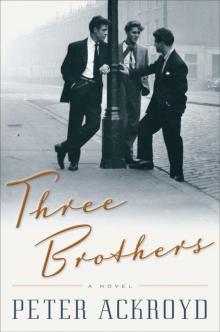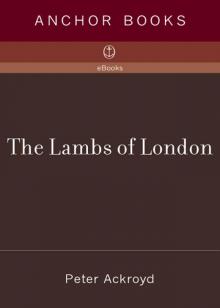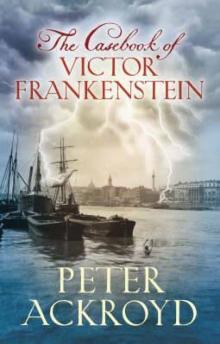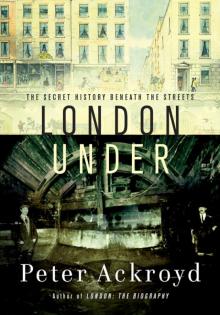- Home
- Peter Ackroyd
Venice Page 19
Venice Read online
Page 19
When the trades marched in procession to greet a new doge, they arranged themselves in predetermined order; the glass-blowers led the way, followed in turn by the smiths, the furriers, the weavers, the tailors, the wool-carders and others. In the rearguard came the fishmongers, the barbers, the goldsmiths, the comb-makers and the lantern-makers. Each trade had its own liveries, its own symbols, and its own band of musicians. It has been estimated that in the late sixteenth century the unskilled labourers and artisans of the city, below the level of guild membership, comprised some ten thousand men and women; if the members of their immediate families are taken into account, they comprised a quarter of the entire population. They were essentially the proletariat feeding Venice’s mercantile capitalism.
The class above the popolani was known as the cittadini. It was a distinction afforded by birth and by residence, and by the duty of paying certain taxes; it was not an economic group in any meaningful sense of the word. An aspirant had to prove that both his grandfather and his father had been born in Venice, and that the family had for three generations been untainted by any form of manual labour. At a later date it was sufficient for a man to have lived in the city for fifteen years and to have paid all the requisite taxes. Once this was determined the citizen was free to enter the ranks of the bureaucracy, for example, that lay behind the Venetian state machine. The cittadini were in large part the civil servants of the city, with all the virtues and vices of that group; but they provided the continuity and efficiency necessary for the business of government. Little or nothing is known of them as individuals. Throughout the history of Venice they were the anonymous and uncelebrated servants of the state. They dressed like, and copied the solemn manners of, the patricians.
At the top of this unified society stood the patricians themselves, the exclusive class or caste that governed the republic throughout its history. Never have so few ruled so peacefully over so many. They have already been described, with their black gowns and stately manner, in previous pages of this book. In the extant portraits they resemble one another in gesture and expression—or, perhaps, in the lack of those elements. Since they are depicted as possessing no interior life to speak of, they are inscrutable. It was said of one doge that no one knew whether he loved or hated anything. Yet their gravity and self-control afforded a sense of continuity and firmness in a floating world. In a world of shifting appearances, they were changeless.
There were poor as well as rich nobles, but the largest number of patricians always wished to retain the exclusivity of their rank. In the late thirteenth, and early fourteenth, centuries the great council was closed to all those outside the charmed circle; it was a form of government by virtue of inheritance. A list of the chosen families was then inscribed in a register that became known as “the golden book.” There were twenty-four of them, recorded in 1486, who had been part of Venetian life from at least the seventh century; they included the Bragadin, the Polani, the Querini and the Zorzi. By the seventeenth century there were approximately 150 families, or clans, coming together in various informal associations of interest. This multiplicity of factions ensured the stability of the state, since no one family or interest could achieve supremacy. Yet they were so relatively few in number that they knew each other very well. They knew the virtues, and the weaknesses, of all those aspiring to high office.
The last surviving relics of the patrician class are still standing. They are the great houses of Venice. Until the sixteenth century even the grandest houses of the patricians were simply known as dwellings, casa or ca’; after that date they were often given the more distinguished appellation of palazzo. Some of them indeed were palaces, of noble rooms and rich furniture. “I never saw palaces,” William Hazlitt wrote in 1824, “anywhere but at Venice.” Their façades can be seen beside both banks of the Grand Canal, while others are lost in the tapestry of alleys and smaller canals that comprise the rest of the city.
In the fourteenth and fifteenth centuries these mansions had a utilitarian function. They were trading post as well as domicile. They represented the collective identity of the family. They represented the honour of the succeeding (male) generations. There were rules encouraging the members of the same family to retain possession of the house, a fixed point in a floating world. Some of the houses looked away from the water, and were assembled around an inner courtyard. The ground floor or central portego was used as a storeroom and as business quarters, opening onto the canals for the easy traffic in goods; there was a water-entrance, and a land-entrance. On the upper floors were the living quarters. The central hall on the first floor, the sala, opened onto suites of rooms on either side. There were also a myriad of small rooms, for the various members of the extended family, as well as “private” staircases. In the fifteenth and sixteenth centuries the hall was made grander, its furnishings more ornate, and its interior decoration more sumptuous. This was the period when the patricians were moving from involvement in merchandise to investment in estates on the mainland.
It was in fact only in the late fifteenth and early sixteenth centuries, when Venice deemed itself to be the new imperial city, that the great houses with grand incrusted façades were built for display. The mouldings, and capitals, and filigree, were part of a public attempt to emphasise the grandeur of the city. Many were decorated with frescoes devised by artists such as Titian and Giorgione. Others, like the Ca’ d’Oro, were encrusted with precious metals. Venice looked like a city of marble and gold. It should be recalled that these were palaces rather than castles; unlike the houses of the nobility in the rest of Italy, they were not fortified or defended in any way. There was no need.
V
Empire of Trade
16
The Lion City
As Venice grew richer, it became more powerful. A city needs a ruling authority, and the acquisition of authority invites arrogance and belligerence. It encourages the will for further power. Venice, surrounded by the sea, could not grow out of its own frontier. But it could be enlarged and enriched by its extension in other lands and in other cities. It could become an empire.
In earliest times la Serenissima, the city of the Virgin, had been given a masculine identity by its citizens. It was the Lion City. The very conditions of its existence made warfare an inevitable part of its history. There was warfare against the natural world and then warfare against its competitors. It was obliged to fight for its survival. Venice had archers and oarsmen and maritime warriors. Sea powers are natural competitors. While land powers may agree to the division of land into frontiers, the ocean has no frontier. Wherever there is sea, there are hostile ships. Throughout its long history, Venice could never rest.
The drawing books of Jacopo Bellini, composed in the mid-fifteenth century, contain many studies of cavaliers and crossbowmen preparing themselves for combat. Half of Bellini’s lifetime was spent in the battles of Venice against other powers. “This nation of sailors,” Petrarch wrote, “was so skilful in the handling of horses and weapons, so spirited and so hardy, that it surpassed all other warlike nations whether by sea or by land.” So it can indeed be construed as a masculine city. The history of Venice was conceived, and composed, as the history of patriarchal families. The government of Venice was patriarchal in all of its elements. The society of Venice was considered to be patrilinear in nature. The image of the city was wholly dependent upon the exercise of paternal authority.
The patrician youth were trained to use the bow, and to command galleys at sea. They were educated in all the knightly virtues, in a period when the chivalric code of warfare was honoured throughout Europe. The first jousts, in Saint Mark’s Square, are recorded as early as 1242. From that time forward they were staged at regular intervals. In Bellini’s drawing books, chivalric opponents dash upon each other in spectacular tournaments. On these occasions the city was given up to the celebration of militarism and the military virtues. It provided the theatre of war. Painters were employed to embellish shields and armour as well
as icons and portraits. Artists, among them Bellini himself, were used to design fortifications and draw military maps. In the sacred paintings of Venice the saints are often seen wielding swords. Saint George, one of the patrons of the city, was the archetypal military saint. This is very different from the picture of Venetians as quick-witted traders or as earnest statesmen. But knightly valour was once an aspect of their culture. How else could the Venetians have created an empire?
So they knew how to use force when it was required. They were quick to strike, when the opportunity presented itself. One conquest led to another conquest. In fact, one conquest demanded another conquest. In a state that never felt itself secure, the condition of the world was always perilous. Unsuccessful generals and admirals were imprisoned, exiled, or killed. When they employed the newly invented cannon against a recalcitrant Italian town, an old chronicle reported that “one would think that God were thundering.” One cannon was named “the Venetian Woman who Casts down Every Wall and Spike.”
The first colonies of Venice were in the lagoon itself; originally the smaller islands had self-ruling or self-sustaining communities. Once each island had its monastery, and its church. But, soon enough, they all became part of Venice itself. The leaders of the city might then take comfort from the opening words of the ninety-seventh psalm: “The LORD reigneth; let the earth rejoice; let the multitude of isles be glad thereof.” The multitude of islands were swallowed up by the great city growing in their midst. Or their communities simply withered away.
Torcello, seven miles (11 km) to the north of the most serene city, was once a thriving place. Before the city of Venice ever rose from the waters, it was a great civic centre for the exiles from Venetia. They had first come in the middle of the fifth century. A cathedral of Byzantine form was raised here in the seventh century. It was built as a refuge and a strength by exiles fleeing from the mainland; the windows of the church have shutters of stone. Wealthy monasteries were founded on its fertile soil. In the tenth century it was described by the Emperor Constantine VII Porphyrogenitus as “magnum emporium Torcellanorum.” Yet the success of Venice led ineluctably to the decay of Torcello. There was no room for two thriving centres of trade in the lagoon. There are some, however, who say that it was poisoned by the malarial waters of the lagoon. The sea was silted up, and the island was surrounded by stagnant ponds. There may be truth to this, but the visitation of disease added only the final blow to a long process of disintegration. Ineluctably Torcello sank in the significance of the world. In the nineteenth century a nobleman of spurious or dubious origin was dubbed as “a count of Torcello.” Now the once thriving island supports a handful of people; all around are wastes of mud-filled creeks and rivulets and what Ruskin described as “salt morass.” The brick campanile, and the mosaics within the cathedral itself, are the only remnants of its faded splendour. The civic square is covered by wild grass. Yet the silence of this island, interrupted sometimes by the soughing of the wind through the reeds or the rustle of rippling waters, is a vivid token of the primeval lagoon to which the first Veneti came. Another symbol can be found here of the Venetian world. There is a restaurant on the island, frequented by the tourists who journey to Torcello as an outdoor museum. It is really no more than that. And might it then somehow anticipate the fate of Venice itself?
On the majority of the islands could once be found a tall campanile and brick-built church; there was a small piazza, with the image of the lion on wall or pillar; there were little clusters of whitewashed houses, their gardens protected from the depredations of the salt wind by neat red fences. Then they were touched by decay more insidious than the wind. The island of Ammiana once boasted eight churches; then it was depopulated and turned into a salt farm. And where did the inhabitants go? They migrated to Venice. All of these dead towns and cities and settlements could once have been proposed as alternatives to Venice; they might have flourished and grown strong, as Venice did. If we were to follow the precepts of Italo Calvino’s Invisible Cities, we might create the possible cities of the lagoon; the distinct customs and dialects of each island might then have created several different cities, resembling and yet not resembling Venice itself. But, then, this would be a fantasy.
Other islands, once under Venetian control, have disappeared. The island of Constanziaca was engulfed by the waters. It had once contained monasteries and churches. It became so woeful, however, that it was turned into a burial site where the bones of the dead were left to bleach in the sun. Then with all its churches and bones it simply subsided into the sea. No one knows its precise position. Other islands suffered a similar fate, among them Terra dei Mani and Terra dei Soleri. Five little islands encircling Murano have been washed away by tides and currents. There is seaweed now where once tall cypresses grew. Some islands were overcome by earthquakes or tidal waves; others were claimed by a slow and general desuetude. They could not compete against the most serene city.
The Venetian authorities turned some of these once flourishing islands into prisons or hospitals. It was one way of pushing the undesirable elements of the population to the margins. It was also an exercise in total power. The island of S. Servolo was turned into a lunatic hospital for men, while the island of S. Clemente was a mental asylum for Venetian women. Sacca Sessola was a place of exile for those suffering from consumption, while the Isola della Grazia held those who burned with fever. On the island of Poveglia were laid out huts for the lepers banished from the city. All these islands were known to the Venetians as “isole del dolore” or the islands of sorrow.
The island of S. Biagio, now called Giudecca, was once a green haven of orchards and gardens; here were a convent, a home for penitent prostitutes and a pilgrims’ hostel. But the secular world of Venice intervened. It became essentially a suburb of the city. Other islands were used as agricultural factories for the markets of the Rialto. In the second half of the fifteenth century the island now known as the Lido became an extension of Venice’s port. It became part of the economic zone that now encircled and sustained the city.
The beginning of the Venetian empire beyond the lagoon can be found in the ninth century. Venice was not as yet a leading sea-power. That position was reserved for the Spanish and for the North Africans. But it needed to control its immediate environment. It had to find, and maintain, a reliable food supply for an increasing population. It needed to secure access to water and to agricultural land. It needed to control the lifelines of its trade. So Venice turned to the mainland. The people of the sea were obliged to conquer terra firma.
Towards the close of the ninth century Venice sacked the rival cities on the Italian coast and took control of the mouths of the Adige and Po rivers. The rivers gave them access to the markets of northern Italy; within a short time the bargemen of the city were offering their wares in Pavia, the capital of Lombardy. The merchants of Venice were prominent, too, in the markets of Verona and Cremona. In the tenth century Venetian markets and warehouses were built on the banks of the rivers Sile and Piave. The Venetians occupied a castle beside the Livenza river, so that their goods could reach the German traders coming down into Italy. By 977 the Venetian traders had a colony in Limoges, and by the next century they had diffused themselves into Marseilles and Toulouse. The corn-growing areas of Treviso and Bassano were acquired. In this period, too, the Venetians began the slow process of purchasing mainland property and territory. Some of the great families of Venice, like the Badoer and Tiepolo, acquired land around Treviso. The larger monasteries purchased estates along the coastal plain. This gradual enlargement of Venetian property continued for seven centuries. The key issue, as always, was that of commerce and in particular of the supply of grain.
Once the trade with northern Italy and much of Europe was considered secure, the governors of Venice turned their attention towards the sea. The merchants already effectively controlled the trade in eastern goods, but the success of that trade demanded that the routes to the East should be strengthened and defended.
The sea was to be made safe for the mass transport of goods. The principal cities of Istria, immediately across the sea from Venice, submitted. The northern part of the Adriatic became known as the Gulf of Venice. Then the Venetian navy worked downwards. By the end of the tenth century it effectively controlled the Middle Adriatic, and set about the conquest of Dalmatia (now part of modern Croatia). The islands and cities of the region surrendered to the superior force and numbers of the Venetians. Some cities, more alarmed by the depredations of the pirates who found safe haven in the small islands and inlets along the Dalmatian coast, invited the doge and his troops to enter their gates. Other cities were tormented by the demands of the petty despots, characteristically living in fortress outposts, and preferred the more benign sovereignty of Venice. Other places were simply happy to enter stable trading relations with the great sea-city. All of them were treated as allies, rather than as subjects, of Venice. Yet in truth the empire was being born. The pirates were defeated. The marauding Slavs were pushed back from the coast. In 998, the doge added the honorific of “dux of Dalmatia” to his title.
The seaway was open for increased traffic with Egypt and, more particularly, with Byzantium. Venice had already become that ancient city’s single most important trading partner, sending slaves and timber in exchange for wine, oil and wheat. In 991 Greek and Arab envoys travelled from the East to pay respect to the new doge, and a year later a treaty confirmed that Venice had been granted “most favoured” status by the Byzantine emperor. It confirmed what was already known. Venice had become the dominant trader of Europe, its commercial supremacy sustained by a vigorous and expanding navy. In return Venice offered its ships as transport for Byzantine soldiers crossing the Adriatic. The city was also, for all practical purposes, inviolable. At the time of the Magyar invasions of Lombardy, at the end of the ninth century, a stone wall was built to defend the islands of the Rialto. A great chain was placed across the water to prevent enemy ships from entering the Grand Canal. But the precautions were unnecessary. The Magyars could not reach the sea-girt city. They were beaten off in the shallow waters of the lagoon, where their ships foundered and sank. The great wall itself was demolished in the fourteenth century. It was not required.

 The Clerkenwell Tales
The Clerkenwell Tales The Canterbury Tales
The Canterbury Tales J. M. W. Turner
J. M. W. Turner Chatterton
Chatterton The Canterbury Tales – A Retelling
The Canterbury Tales – A Retelling Alfred Hitchcock
Alfred Hitchcock Three Brothers
Three Brothers Wilkie Collins
Wilkie Collins Venice
Venice Poe
Poe The Lambs of London
The Lambs of London London
London Queer City
Queer City Revolution, a History of England, Volume 4
Revolution, a History of England, Volume 4 Venice: Pure City
Venice: Pure City Foundation
Foundation Thames
Thames The Plato Papers
The Plato Papers The house of Doctor Dee
The house of Doctor Dee Rebellion: The History of England from James I to the Glorious Revolution
Rebellion: The History of England from James I to the Glorious Revolution Albion: The Origins of the English Imagination
Albion: The Origins of the English Imagination The Fall of Troy
The Fall of Troy The Death of King Arthur
The Death of King Arthur The Trial of Elizabeth Cree
The Trial of Elizabeth Cree London: The Biography
London: The Biography The Casebook of Victor Frankenstein
The Casebook of Victor Frankenstein Hawksmoor
Hawksmoor Charlie Chaplin
Charlie Chaplin London Under
London Under